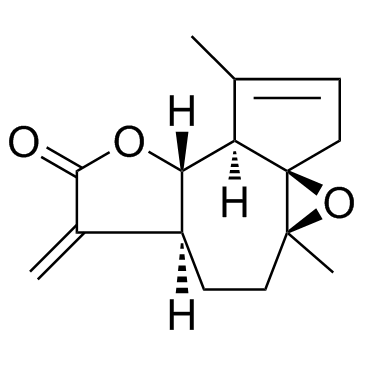84692-91-1
| Name | arglabin |
|---|---|
| Synonyms |
3H-Oxireno[8,8a]azuleno[4,5-b]furan-8(4aH)-one, 5,6,6a,7,9a,9b-hexahydro-1,4a-dimethyl-7-methylene-, (3aR,4aS,6aS,9aS,9bR)-
3H-Oxireno[8,8a]azuleno[4,5-b]furan-8(4aH)-one, 5,6,6a,7,9a,9b-hexahydro-1,4a-dimethyl-7-methylene-, (3aR,4aS,6aS,9aS,9bR)- (3aR,4aS,6aS,9aS,9bR)-1,4a-Dimethyl-7-methylene-5,6,6a,7,9a,9b-hexahydro-3H-oxireno[8,8a]azuleno[4,5-b]furan-8(4aH)-one (+)-Arglabin |
| Description | Arglabin is a sesquiterpene gamma-lactone is isolated from Artemisia glabella; anticancer natural compound.IC50 value:Target: anticancerin vitro: Arglabin-stimulated macrophages displayed a strong cytotoxic activity and the lowest doses (1.25 micrograms/mL and 0.125 micrograms/mL) induced a significant stimulation of cell mitochondrial metabolism, which correlated with [3H]TdR uptake by J774.1 cells under the same experimental conditions. Arglabin triggered the production of the three cytokines from J774-1 cells. However, the pattern of cytokine secretion differed to some extent, according to the methodology used for cytokine measurement: either traditional bioassay or specific immunoassay (ELISA) [1]. Arglabin exhibits antiexudative and antiproliferative properties on the models of acute aseptic inflammation caused by formalin, carrageenan, and histamine, and on the model of proliferative inflammation accompanying cotton-pellet granuloma [2]. Arglabin is able to reduce the proportion of AML stem cells (CD34+CD38-) in primary AML cells [3]. |
|---|---|
| Related Catalog | |
| References |
| Density | 1.2±0.1 g/cm3 |
|---|---|
| Boiling Point | 404.6±45.0 °C at 760 mmHg |
| Melting Point | 102 °C |
| Molecular Formula | C15H18O3 |
| Molecular Weight | 246.302 |
| Flash Point | 171.3±23.3 °C |
| Exact Mass | 246.125595 |
| PSA | 38.83000 |
| LogP | 1.74 |
| Vapour Pressure | 0.0±0.9 mmHg at 25°C |
| Index of Refraction | 1.571 |


